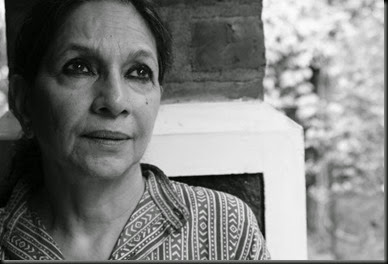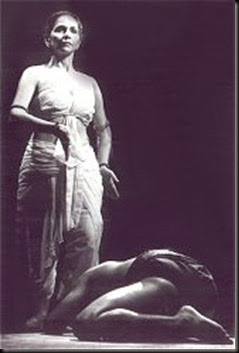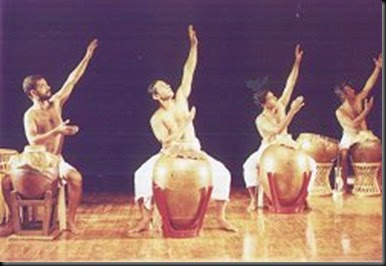It is All Solo… Ekaharya Fetival at Tripunithura, Kerala, Dec 25-28, 2014.
Solo performances are becoming more and more common these days… Solo gives the actor to give him freedom to work alone so that the planning and scheduling of rehearsals can be done comfortably. Of course this trend is against the community and ensemble nature of theatre, but it gives the chance to do more experimentation. Many a times the format of solo is a challenge and test to the art and craft of the actor, to express without the other actors on stage. It gives challenges to the designer/director to find a suitable narrative mode so that suits one specific actor. It may be easier to travel and perform with one actor and less number of crew. It may make the budget, the cost of production and performance to come down, even if it is not the case always. It is also seen the current trend is to substitute the lack of other actors with technology and other devices…
Solo performances and its increased importance in the theatre scenario poses many questions to debate and discuss.
It is in this context the Ekaharya Performance Festival, a festival for solo performances conduced by Rajiv Varma Memorial Trust, Tripunithura, is being held during December 25 - 28, 2014 at Kalikotta Palace, Tripunithura.
A total of 14 plays will be performed during the four-day-long festival. Dr. Abhilash Pillai is the festival director. The schedule is..
December 25
6.00 p.m. Samjhoutha (Performer: Manwendra Kumar Tripati / Dir: Pravin Kumar Gunjan / written by Suman kumar based on the story of Gajanan MAdhav Muktibodh/The Fact Art and cultural society, Bihar / Hindi / 70 min)
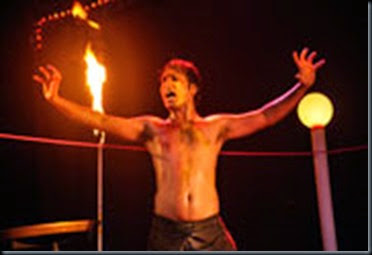 Samjhouta presents the world as circus and showcases the story of a young man who is helpless in the circumstances and situations around him. The search for a job, the usual pain of running from one office to another is the plot of the play. He confronts the harsh reality of today –the changing face of today’s man, where the pain and sorrows of the clown are portrayed as a source of amusement and entertainment. Sometimes he is ready to compromise even with his own ideals and thoughts for his success or to be alive. In this blind race of globalisation, Samjhouta is an attempt to reveal the hard realities of life.
Samjhouta presents the world as circus and showcases the story of a young man who is helpless in the circumstances and situations around him. The search for a job, the usual pain of running from one office to another is the plot of the play. He confronts the harsh reality of today –the changing face of today’s man, where the pain and sorrows of the clown are portrayed as a source of amusement and entertainment. Sometimes he is ready to compromise even with his own ideals and thoughts for his success or to be alive. In this blind race of globalisation, Samjhouta is an attempt to reveal the hard realities of life.
With the help of classical-traditional story telling style and theatrical devices, the story is performed as a modern and contemporary theatrical performance piece, where the actor is a bridge between the audience and the content of the story.
7.30 p.m. A Bird’s Eye View (Performer & Dir: Choiti Ghosh / Tram Theatre, Mumbai / Non-Verbal / 60 min)
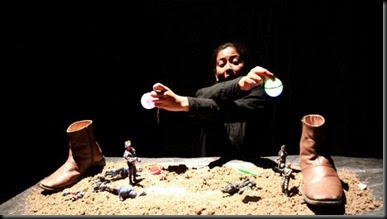 The story of a war pigeon during World War II is told with the help of objects, drawings/paintings and an actor who handles them. This form of theatre is a sub-genre of puppetry; it lifts everyday objects and lends them a persona. Objects work as metaphors; the entire show is created with metaphors like paintings, children's toys, games (“to show that war is finally a game”) and a pair of boots (“a symbol of power”).
The story of a war pigeon during World War II is told with the help of objects, drawings/paintings and an actor who handles them. This form of theatre is a sub-genre of puppetry; it lifts everyday objects and lends them a persona. Objects work as metaphors; the entire show is created with metaphors like paintings, children's toys, games (“to show that war is finally a game”) and a pair of boots (“a symbol of power”).
Object theatre is a relatively a new art form and is an offshoot of puppetry. It involves the use of everyday objects that we take for granted. These objects though, are capable of speaking to us quite powerfully and taking us right into the heart of deep emotional experiences; a form of theatre which does away with actors, speech and costumes. The object theatre form has the potential for crunching several narrative conventions, making imaginative leaps and staying in the realm of the abstract.
9.00 p.m. Pandvani (Traditional Performing Art Form from Chhathisgarh / Performer: Teejan Bhai / 60 min / Hindi)
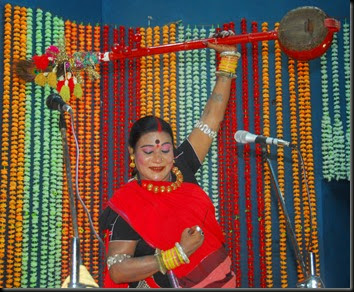 Pandwani is musical form of storytelling of Indian mythological stories. This form is very famous in Chhattisgarh, was mainly used for Mahabharata Stories. Teejan Bai started performing this male dominated form from the age 13. Now she is the embodiment of this unique traditional form and is performing all around the globe with her charismatic stage presence, singing, impromptu dance, and matchless performance. She has been awarded with Padma Bhushan, Sahitya Akademi award etc.
Pandwani is musical form of storytelling of Indian mythological stories. This form is very famous in Chhattisgarh, was mainly used for Mahabharata Stories. Teejan Bai started performing this male dominated form from the age 13. Now she is the embodiment of this unique traditional form and is performing all around the globe with her charismatic stage presence, singing, impromptu dance, and matchless performance. She has been awarded with Padma Bhushan, Sahitya Akademi award etc.
Pandavani, literally means stories of Pandavas, and involves enacting and singing with instrumental accompaniment of an ektara or a tambura in one hand and sometimes a kartal in another. Interestingly, as the performance progresses, the tambura becomes her only prop during her performances, sometimes she uses it to personify a gada, mace of Arjun, or at times his bow or chariot, while others it becomes the hair of queen Draupadi, allowing her to play various character with effective ease and candour. She at times is improvising and offering critique on current happenings and brings forth new insights to the story by giving commentary and interjections and enhances the dramatic effect of the performance…Gradually, as the story progresses, the performance becomes more intense and experiential
December 26
6.00 p.m. C Sharp C Blunt (Performer: M.D. Pallavi / Dir. Sophia Stepf / Text Collaborators Swar Thounaojam, Irawati Karnik /Flinn theatre / English / 70 min)
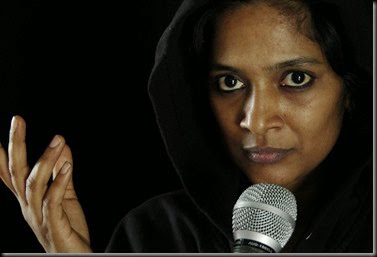 Winner of three META Awards (Mahindra Excellency in Theatre Awards) 2014 in Delhi for Best Original Script, Best Actress in a Leading Role and Best Innovative Sound/Music Design.
Winner of three META Awards (Mahindra Excellency in Theatre Awards) 2014 in Delhi for Best Original Script, Best Actress in a Leading Role and Best Innovative Sound/Music Design.
Meet Shilpa, an attractive, interactive and user-friendly mobile phone app that has been projected to be the most popular app of 2013. Created using the latest technology, Shilpa will sing for you - in the flesh. She will sing the songs you want to hear with her sugary and husky voice, and shake her hips when you want her to dance to your favourite tune. Best of all, she behaves exactly the way women are supposed to behave in the eyes of men; until the next update is released. Singer-actress MD Pallavi in her first ever solo performance is excelling in this witty, humorous and satirical interrogation of what it is like being a woman in the entertainment industry today.
The Indo-German collaboration explores the realms of digital dramaturgy, repetition and user choices to create a new hybrid form of theatre-meets-performance art, a funny, sarcastic and political rendition of the latest App in the market.
7.30 p.m. Josephinte Radio (Performer: Jayachandran Thakazhikkaran / Dir: K.K.Ramesh / Thespian Theatres, Kochi / Mal / 50 min) 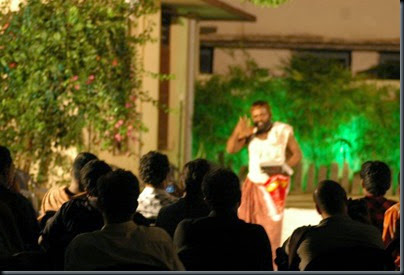 ‘Josephinte Radio' was written for stage presentation by K.R. Ramesh with 10 characters. Jayachandran adapted it into the mode of a street play with only one character.
‘Josephinte Radio' was written for stage presentation by K.R. Ramesh with 10 characters. Jayachandran adapted it into the mode of a street play with only one character.
The play revolves around a simpleton named Joseph for whom the radio is very important. It is his best friend who sang songs for him, gave him good news and above all, connected him to the world outside. All of a sudden, he finds that it has stopped working, upsetting the balance of life. He goes from mechanic to mechanic and even to scientists to get it repaired, but in vain. They all fail him, citing one reason or the other. At the end of the play, Joseph cries out to the audience, “Those who are marching towards polling stations, listen, Joseph's radio is damaged.”
9.00 p.m. – To Kill or Not to Kill (Performer: Jilmil Hazarika / Dir: Ovlyakuli Khodjakuli / Arnav Art, Delhi / Multilingual / 65 min)

Ovlyakuli Khodjakuli, from Turkmenistan, known from his dynamic sets and artistic theatre dramatizes the first 3 stories in his production of Little Big Tragedies; In Mozart and Salieri, Salieri is a hardworking, but not very creative student whose jealousy of Mozart's genius drives him to murder Mozart. Don Juan in The Stone Guestlusts for Dona Anna, so he kills her husband and then tries to woo her. In The Feast during the Plague, a plague survivor struggles with the conflict between the loss of lives (which include his wife and mother) and to live his own life to the fullest.
10.15 p.m. If it be Now - Fragments and Impressions of Hamlet (Devised and performed by Arka Mukhopadhyay / The Arshinagar Project, Kolkata / English &Bengali / 40 min)
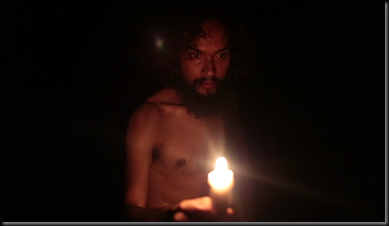 The piece is based on works by Boris Pasternak, Heiner Muller, Jan Kott and others, as well as original writing and Shakespeare's play. Combining elements of structured action and improvisation, it looks not for meaning or a message, but at experience - at an utterly human Hamlet, trapped inside a prison of words; responding as much to the physical space and the presence of the watchers, as to the universe of Hamlet. In effect, this is a passion play that tries to find illumination out of darkness.
The piece is based on works by Boris Pasternak, Heiner Muller, Jan Kott and others, as well as original writing and Shakespeare's play. Combining elements of structured action and improvisation, it looks not for meaning or a message, but at experience - at an utterly human Hamlet, trapped inside a prison of words; responding as much to the physical space and the presence of the watchers, as to the universe of Hamlet. In effect, this is a passion play that tries to find illumination out of darkness.
The performance has violent images and explicit content, hence viewer discretion is advised. It is open only to those above 18 years of age…
December 27
6.00 p.m. Unseen (Performer: Kalyanee Mulay / Dir: Vishnupad Barve / Process Theatrez, Porvorim, Goa/ English / 60 min)
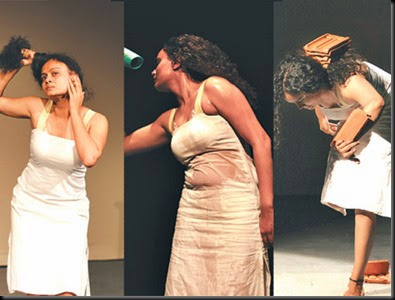 This play seems to interrogate a letter of Rabindranath Tagore and the poet’s misconstrued notion of womanhood as represented in the letter written with reference to a lecture of Pandita Ramabai, which Mulay recites and then goes on to depict inevitable like menstruation, child birth, motherhood, pain and surrender, a woman’s life in a patriarchal society. The play looks into the invisible and key practises like beautification of the female body and its subsequent commodification that lead to an awareness as a sexual object, mostly through instances of sexual harassment. This non-verbal performance was accompanied only by the sound installation in a setting of a house depicting all the rituals a woman has to go through in her life, thoroughly examines aspects like woman’s body, the male gaze on a female body, biological cycle of a woman, et cetera. Choreographed, rather than scripted, the play employs archetypical postures and gestures usually kept hidden and private—a woman giving birth, having an abortion, being harassed by unwanted physical attention, or even a submissive being pulled about by her hair—and movements that resonate with daily middle-class urban rituals like shaving bare legs, drying hair with a hair dryer, relishing a Cadbury chocolate by herself. Her body steps into the realm of material metaphor as she assumes the role of Woman everywhere and of all time, weighed down by her social roles and cultural burdens.
This play seems to interrogate a letter of Rabindranath Tagore and the poet’s misconstrued notion of womanhood as represented in the letter written with reference to a lecture of Pandita Ramabai, which Mulay recites and then goes on to depict inevitable like menstruation, child birth, motherhood, pain and surrender, a woman’s life in a patriarchal society. The play looks into the invisible and key practises like beautification of the female body and its subsequent commodification that lead to an awareness as a sexual object, mostly through instances of sexual harassment. This non-verbal performance was accompanied only by the sound installation in a setting of a house depicting all the rituals a woman has to go through in her life, thoroughly examines aspects like woman’s body, the male gaze on a female body, biological cycle of a woman, et cetera. Choreographed, rather than scripted, the play employs archetypical postures and gestures usually kept hidden and private—a woman giving birth, having an abortion, being harassed by unwanted physical attention, or even a submissive being pulled about by her hair—and movements that resonate with daily middle-class urban rituals like shaving bare legs, drying hair with a hair dryer, relishing a Cadbury chocolate by herself. Her body steps into the realm of material metaphor as she assumes the role of Woman everywhere and of all time, weighed down by her social roles and cultural burdens.
The entire play used a pressure cooker on a burning gas stove, gas cylinder, dustbin and other utensils as props. The whistling of the cooker along with other sounds created through different utensils (that seemed like sound installation) created coherence with the performer’s actions and objects used as props.
7.30 p.m. Moment Just Before Death (Performer: Manoj Omen / Dir: Liju Krishna / Saga Entertainment, Kochi / Mal / 75 min)
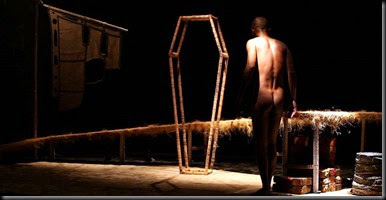 The play “Moment Just before Death” pivots around an old man, whose body sweeps through evanescent memories, pleasant smell of tender toddy, wild flowers drenched in longing and the endless waiting for his own coffin. Bereft of joy and hope he prepares himself for death, the only gate of deliverance for him. Years of waiting on the threshold of death is depicted as a prolonged curse. He prepares his body with the sanctity of rituals associated with the ceremony of death. The coffin is the seminal image which gives life to events and characters and the old man is shaping up his coffin day by day. The girl with flowers, Old man as a florist in the cemetery and the cult of Muthappan, intensifies the tragic posture of humanity in the bleak and macabre backdrop of the play.
The play “Moment Just before Death” pivots around an old man, whose body sweeps through evanescent memories, pleasant smell of tender toddy, wild flowers drenched in longing and the endless waiting for his own coffin. Bereft of joy and hope he prepares himself for death, the only gate of deliverance for him. Years of waiting on the threshold of death is depicted as a prolonged curse. He prepares his body with the sanctity of rituals associated with the ceremony of death. The coffin is the seminal image which gives life to events and characters and the old man is shaping up his coffin day by day. The girl with flowers, Old man as a florist in the cemetery and the cult of Muthappan, intensifies the tragic posture of humanity in the bleak and macabre backdrop of the play.
The play attempts to represent graphically the old man’s views to the spectators straight away theatrically when he attempts to reorganize his layers of reveries lauded with love, gruesome realities of life and thoughts. The play is in a nonlinear narrative with eruptions of events and fluidity of situations and characters, the inter relationship between local cultures and languages and the trauma of alienation. The play brings home the Old man’s passage through various facets of his life by incorporating props, images and dimensions of visual plane to envisage a theatre of experience and interrogation.
Liju Krishna won the META award for best stage design and best actor award for Manoj Omen.
9.00 p.m. Agleyum Cleopatrayum (Performer: Pooja Mohanraj / Dir: Chandradasan / Lokadharmi, Kochi / Mal / 60 min) 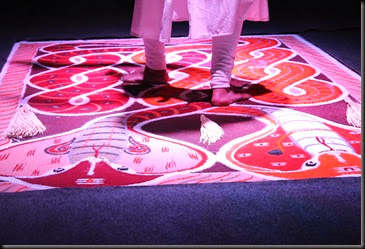 Agleyum Cleopatrayum (Egle & Cleopatra), is inspired from the folk myth of Egle from Lithuania and William Shakespeare’s Antony and Cleopatra. The experience of the two characters Cleopatra and Egle are entwined together to probe into the different manifestations of love. Both Cleopatra and Egle were victims of Love; love with different facades and connotations. The experiences of these two characters from two different cultures times and spaces are reconnoitered so as to extrapolate and explore the contemporary female experience.
Agleyum Cleopatrayum (Egle & Cleopatra), is inspired from the folk myth of Egle from Lithuania and William Shakespeare’s Antony and Cleopatra. The experience of the two characters Cleopatra and Egle are entwined together to probe into the different manifestations of love. Both Cleopatra and Egle were victims of Love; love with different facades and connotations. The experiences of these two characters from two different cultures times and spaces are reconnoitered so as to extrapolate and explore the contemporary female experience.
The love of Cleopatra the Queen of Egypt, seems to contain a venomous strain. Cleopatra, ‘the charming serpent of Nile’ remain a mystery; she cleverly uses the unparalleled sensuality of her body to make men kneel at her whims and fancies. Here love is highly sensual with ecstasies of physicality, wild streams of fantasy and extreme romanticism.
Why Cleopatra fell in love with all those men - from Caesar to Antony - who came across her? Was Cleopatra a sexual maniac with infinite shades of lust? She identifies love as the ‘most delicious poison’, as ‘an excellent falsehood’ or a ‘riotous madness’. It seems that the love act of Cleopatra is not merely to satisfy her carnal instincts, but also is a defense mechanism to protect her country from enemies and invaders and colonizers. Cleopatra uses her unmatched talents and perspicacity in the art of love to conquer the conqueror. She calls herself as ‘Egypt’ and her desire is to be buried in the mud and waters of Egypt than taken to the royal courts of Rome; this reinforces that her act of love may be a political armor to defeat the invader. There is no escape for the invader from this enchanting queen, and her infinite scheme of seductions. But the tragedy is that in the end Cleopatra herself falls as the victim of her own prangs of passion, and emotional ecstasies. The hunt and prey merges to be one; and as always the ultimate loser is Cleopatra, the female. 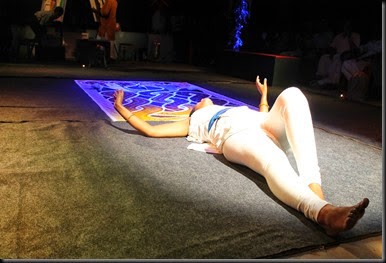 On the contrary Egle the mythical character from Lithuania, who is forced to marry a snake is a simple farmer girl with all the innocence of a forest breeze. She had no choice to make, but marry Zilvinas, the serpent prince and go to his amber castle beneath the sea. She adapted herself to this alien environment and started living there happily. After few years she endeavors to visit her home to meet her folks. The condition to Zilvinas was that she shall not reveal the name of her husband; she should come to the sea and call his name to return to their abode. If he is alive ‘may the sea foam milk, if dead may the sea foam blood.’ But as she returns, he comes as a stream of blood, a sign that her promise had been broken. Brothers have got his name from the youngest child and they killed him to ‘save her from the clutches of a snake and save the family honor’. Engulfed in inexplicable outpour of emotion which empowers her, she transforms herself into a deep rooted evergreen fir tree, instead of returning with her folk.
On the contrary Egle the mythical character from Lithuania, who is forced to marry a snake is a simple farmer girl with all the innocence of a forest breeze. She had no choice to make, but marry Zilvinas, the serpent prince and go to his amber castle beneath the sea. She adapted herself to this alien environment and started living there happily. After few years she endeavors to visit her home to meet her folks. The condition to Zilvinas was that she shall not reveal the name of her husband; she should come to the sea and call his name to return to their abode. If he is alive ‘may the sea foam milk, if dead may the sea foam blood.’ But as she returns, he comes as a stream of blood, a sign that her promise had been broken. Brothers have got his name from the youngest child and they killed him to ‘save her from the clutches of a snake and save the family honor’. Engulfed in inexplicable outpour of emotion which empowers her, she transforms herself into a deep rooted evergreen fir tree, instead of returning with her folk.
10.15 p.m. If it be Now - Fragments and Impressions of Hamlet (Devised and performed by Arka Mukhopadhyay / The Arshinagar Project, Kolkata / English &Bengali / 40 min)- Repeat Show.
December 28
5.00 p.m. Dr!Vikadan (Directed and performed by Vinu Joseph/ Theatre Lab Palakkadu/ 30 min)
This impromptu performance is a theatre clown show…
6.00 p.m. Majuli (Performer: Silpa Bordoloi / Brahmaputhra Cultural Foundation, Assam)
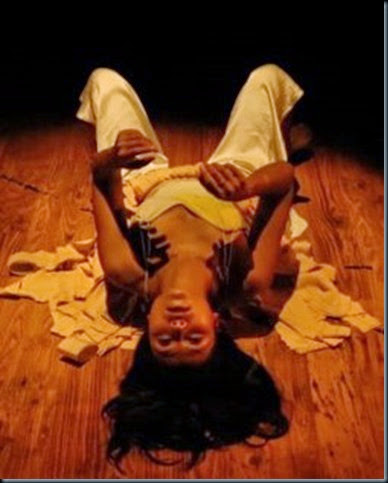 Majuli, a river island in Brahmaputra in Assam, inspired movement artist Shilpika Bordoloi to create a performance, combining dance and physical theatre. “The performance includes motifs representative of what Majuli means to me, and is based on the Vaishnav, Deori and Mising communities. Every other element also plays a role, including the costume, music and light design,” says Shilpika.
Majuli, a river island in Brahmaputra in Assam, inspired movement artist Shilpika Bordoloi to create a performance, combining dance and physical theatre. “The performance includes motifs representative of what Majuli means to me, and is based on the Vaishnav, Deori and Mising communities. Every other element also plays a role, including the costume, music and light design,” says Shilpika.
Majuli is part of Katha Yatra, a multi-media project that researches cultural practices along the Brahmaputra River, where the many moods of water are central to the performance and the sinuous movements of her lithe body resemble a river slowly meandering along its course. Shilpika alternates between the slow and fast pace to take us to a climax where the annual floods leave the island ravaged and torn and then is reborn again in a renewal of the cycle, which has been continuing for ages.
7.30 p.m. Notes on Chai (Performer: Jyoti Dogra / Mumbai / English, Hindi, Punjabi / 100 min)
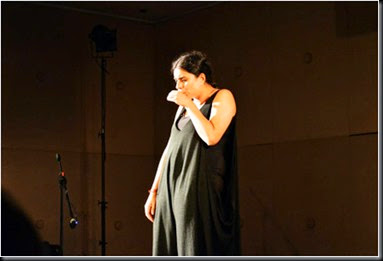 Tea is synonymous with Indian lifestyle and “Notes on Chai” features a collection of thoughtful and entertaining excerpts of everyday conversation one has over tea, interwoven with abstract sound explorations that attempt to relocate our relationship with the mundane. Interspersed with these portrayals are abstract, guttural sounds inspired by Tibetan chanting, western harmonics and extended vocal techniques that seeks to stretch the limits of spoken language. With basic light and costume, Dogra holds her own on stage through extended vocal techniques providing unconventional sonic textures, to her world of conversations over tea.
Tea is synonymous with Indian lifestyle and “Notes on Chai” features a collection of thoughtful and entertaining excerpts of everyday conversation one has over tea, interwoven with abstract sound explorations that attempt to relocate our relationship with the mundane. Interspersed with these portrayals are abstract, guttural sounds inspired by Tibetan chanting, western harmonics and extended vocal techniques that seeks to stretch the limits of spoken language. With basic light and costume, Dogra holds her own on stage through extended vocal techniques providing unconventional sonic textures, to her world of conversations over tea.
Dogra says. “As I began working with sounds, the idea of working with language followed – exploring language as a way of keeping the mask, keeping the distance, and how these distances and masks often reveal more than we would care to show in conversations.”
9.00 p.m. Jeevit ya Mrit (Performer: Seema Biswas/ Written by Geetanjali Shree/ Dir: Anuradha Kapoor / Vivaldi Cultural Society, New Delhi / Hindi / 60 min)
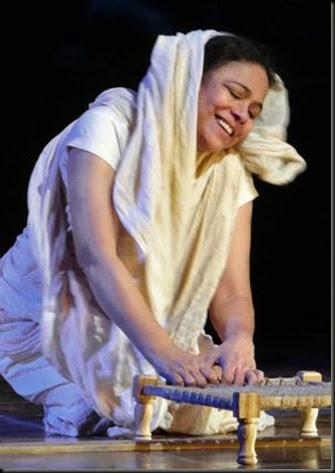 Rabindranath Tagore’s Jeevit-Ya-Mrit is said to be his most outstanding short story about Kadambari, a widow who came back from the dead only to die again because everyone thought she was a ghost. Kadambari wakes up in the crematorium, unsure of whether she is dead or alive. In this weird ambience in the dark night in a hallucinatory mood she recollects her past and as if in dream leaves the cremation ground and moves to the house of her childhood friend for shelter.
Rabindranath Tagore’s Jeevit-Ya-Mrit is said to be his most outstanding short story about Kadambari, a widow who came back from the dead only to die again because everyone thought she was a ghost. Kadambari wakes up in the crematorium, unsure of whether she is dead or alive. In this weird ambience in the dark night in a hallucinatory mood she recollects her past and as if in dream leaves the cremation ground and moves to the house of her childhood friend for shelter.
Seema Biswas rants and raves, questions and critiques the society that left her for dead and when she returned alive, refusing to accept her statement that she was alive. Biswas shifts from one character to another, intercutting it with Kadambari’s questioning, scathing and incisive voice soaked with an electric chemistry and an energy challenging for a character — submissive, surrendering and affectionate when alive. The props, setting, lighting and the ‘look’ Kadambari is given invests the ambience with the pall of death which creates from within itself, the anguished cry of a woman begging the world to let her live. Through her monologue and a variety of tones ranging from a whisper to loud delivery and intensity of emotions, she imparts insights into the traumatic, insulted and humiliated world of a Hindu widow.
Labels: Agleyum Cleopatrayum, Anuradha Kapur, Chandradasan, Lokadharmi, Seema Biswas, Teejan Bhai

